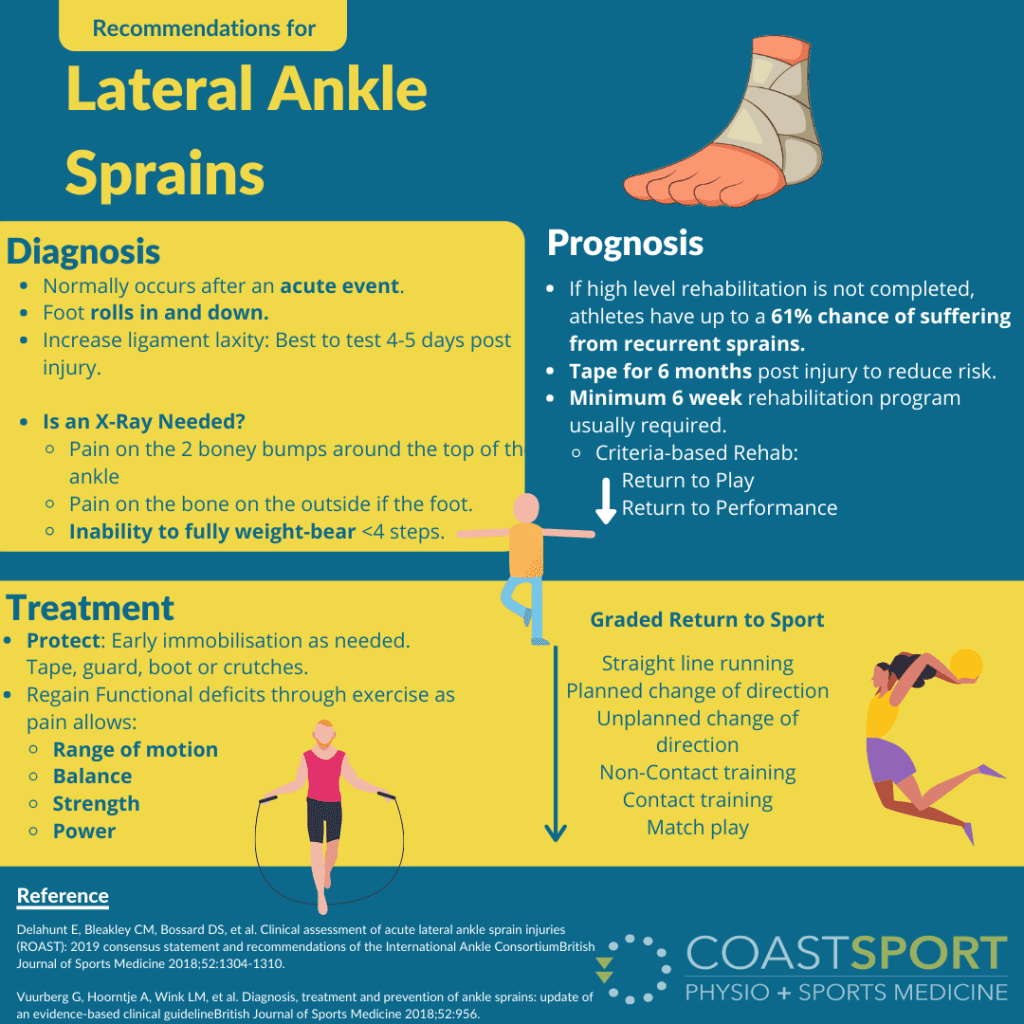
Ankle sprains can occur in 3 key areas of the ankle. The outside, inside and across the top of the ankle. An injury to the inside of the ankle and commonly a sprain to the large Deltoid ligament, and an injury across the top of the ankle is commonly known as a Syndesmosis sprain.These 2 injuries are not as common as an injury to the outside of the ankle, however they are associated with a longer return to sport.
This page will focus on the outside of the ankle sprain, which is commonly known as a lateral ankle sprain.There are 3 ligaments on the outside of the ankle, they are called Anterior talofibular (ATFL), Calcaneofibular (CFL) and Posterior talofibular ligaments (PTFL). The ATFL is the most common ligament associated with a lateral ankle sprain, however it is common for the CFL to be involved alongside it.

Lateral ankle sprains are common in most change of direction sports. These can include soccer, AFL, football, basketball, volleyball, netball, gymnastics and dance to name a few.
Mechanism of injury
A lateral ankle sprain normally occurs after an acute event. During this event the foot normally rolls in and down, known as an inversion episode. These injuries can be both contact and non-contact. The most common mechanisms of injury are while changing direction at high speed or landing on an object such as an opposition’s foot while landing from a jump.
Key Assessments Required:
A thorough clinical assessment from your Physiotherapist is required to diagnose an ankle sprain. Your Physiotherapist will conduct an in-depth interview combined with a physical exam to diagnose your ankle sprain. The physical assessment will include tests that assess your ankle range of motion, strength, balance and ligament integrity. Further investigations such as an X-Ray or MRI are sometimes required, however, this depends on the individual case, these investigations are used to support the clinical assessment. Your Physiotherapist is able to refer you for these investigations if clinically appropriate.
Evidence-based treatment/management required
Your Physiotherapist at Coast Sport will provide you with a high level rehabilitation plan which will include the following:
- Pain/Swelling management strategies.
- Early immobilisation: This can include tape, brace, boot or crutches depending on the severity of the ankle sprain
- Exercise plan to regain functional deficits in the following areas:
- Range of motion
- Balance
- Strength
- Power
- Return to sport planning
Return to Play / Prognosis:
Returning to sport from an ankle sprain is multifactorial. A criteria-based rehabilitation plan is used. A criteria based rehabilitation plan is as follows:
- Settle acute pain
- Regain function on day-to-day tasks
- Straight line running
- Planned change of direction
- Unplanned change of direction
- Non-contact training (modified training)
- Contact training (full training)
- Match play
Running alongside this criteria-based return to sport plan is accompanied by a minimum 6-week rehabilitation program. If return to sport is achieved in less than 6 weeks, this rehabilitation plan should continue for a minimum 6 weeks. If high-level rehabilitation is not completed, athletes have up to a 60% chance of suffering from recurrent sprains.
Ankle taping or bracing is recommended for 6 months post-injury to help reduce the risk of recurrent sprains which can lead to chronic ankle instability.
 Helping the Central Coast Feel Well, Move Well and Perform Well!
Helping the Central Coast Feel Well, Move Well and Perform Well!